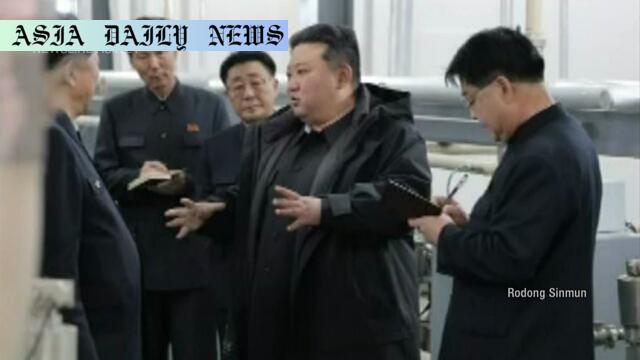Nuclear: Kim outlines 5-year defense plan amid unstable security situation, emphasizing weapons-grade materials for sovereignty.

Kim Jong Un’s Visit to Nuclear Facilities
North Korean leader Kim Jong Un recently inspected multiple nuclear facilities, including a site believed to be a uranium enrichment plant and an institute focused on nuclear weapons innovation. These inspections, reported by the Workers’ Party newspaper Rodong Sinmun, highlight North Korea’s intent to bolster its nuclear capabilities in response to perceived threats and escalating regional tensions.
The Five-Year Defense Plan Nearing Completion
During his visit, Kim referenced a five-year defense plan that is coming to an end in 2023. Central to this plan are efforts to expand the production of weapons-grade nuclear materials. This underscores North Korea’s continued commitment to its nuclear program, which the regime views as vital to ensuring sovereignty and enduring security in an increasingly unstable geopolitical environment. Kim emphasized that these nuclear developments were a defensive measure aimed at strengthening their position against what he termed as ‘vicious’ and ‘hostile’ countries.
Perceived Regional Instability and Long-Term Confrontation
One critical aspect of Kim’s statement is his acknowledgment of the “unstable security situation” surrounding North Korea. He described the need to prepare for a prolonged confrontation with adversarial nations, which the regime believes are intent on undermining its sovereignty and interests. Unwavering in his resolve, Kim reiterated that North Korea’s nuclear shield is pivotal for safeguarding its future.
North Korea’s Weapons-Grade Material Production
Kim’s insistence on increasing the production of weapons-grade nuclear materials signals an aggressive shift in strategy. As global political tensions rise, North Korea’s ambitions seem unwavering, with the regime signaling its readiness to take measures to ensure its ‘right to develop,’ a statement that carries weight considering ongoing international sanctions against its nuclear activities.
Implications for International Relations
Kim’s actions and statements are likely to exacerbate already fraught relations between North Korea and various international players, particularly the United States, South Korea, and Japan. The timing of the nuclear facility visits, just days after the inauguration of a U.S. president, appears to be a calculated message emphasizing North Korea’s defiance and commitment to its nuclear goals.
Global Repercussions and Future Concerns
These developments pose significant challenges for global security. With Kim advocating a militarized approach to foreign policy and a determined push for nuclear proliferation, the international community faces a dilemma on how to respond effectively. Diplomatic strategies and sanctions will undoubtedly be re-evaluated in light of North Korea’s increasingly assertive stance.
Conclusion
The inspection of nuclear facilities and the reaffirmation of a long-term defense strategy under Kim Jong Un illustrate North Korea’s unwavering commitment to solidifying its nuclear position. As the regime strengthens its nuclear shield, it raises urgent questions about regional stability, international security, and the nature of diplomacy in the coming years. The world watches with caution, as these actions have the potential to reshape the balance of power in East Asia and beyond.
Commentary
Understanding North Korea’s Strategic Calculations
Kim Jong Un’s recent movements, as both symbolic and strategic, offer significant insights into North Korea’s mindset. By inspecting nuclear facilities and emphasizing the production of weapons-grade materials, Kim is reaffirming his nation’s commitment to security through deterrence. Such actions, while provocative, are deeply rooted in North Korea’s view of itself as a nation under siege from external forces.
Why Timing Matters
It’s no coincidence that these visits and proclamations were made shortly after the inauguration of U.S. President Donald Trump. North Korea has historically timed its nuclear demonstrations and messaging to coincide with political transitions in the U.S., using the uncertainty to underscore its determination and capabilities. It’s a calculated move designed to assert dominance and signal that North Korea will not yield to external pressures.
The Broader Implications
Kim’s actions raise numerous questions about the effectiveness of international diplomacy and sanctions. North Korea, despite decades of punitive measures, continues to prioritize its nuclear program above all else. This persistence challenges the global community to consider whether current approaches are sufficient or if more innovative solutions are required. However, any such recalibration carries risks, as it could provoke unintended escalations.
A Call for Perspective
While it’s easy to view North Korea’s moves as clear provocations, it’s essential to approach the situation with a nuanced perspective. Understanding the regime’s motivations—the desire for security, sovereignty, and recognition—is critical in finding pathways toward de-escalation. Diplomacy, though difficult, must remain the focus if regional and global stability is to be preserved.


